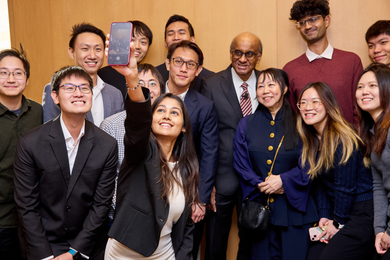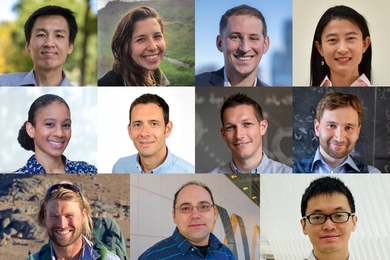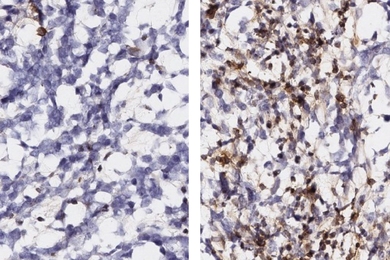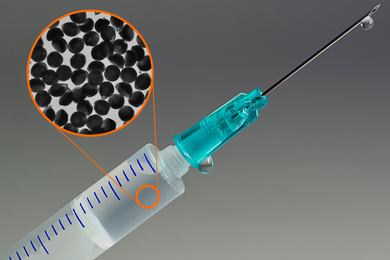As the world’s most pressing challenges in infrastructure and environment evolve, so do the research areas and specialties of MIT Department of Civil and Environmental Engineering (CEE) faculty to meet these needs.
To keep alumni and community members informed of the current research and initiatives in the department, CEE held its annual New Research Reception on Oct. 26. Featuring an update on the status of the department and presentations on new research developments from four distinguished faculty members, the event highlighted the global contributions of CEE research and provided a glimpse into the imminent impact to come.
“There’s nothing better than having alumni come back to MIT and see the light and sparkle in their eyes. It reminds me of the time when they were students; some of the alumni here tonight I met when they were students,” said Markus Buehler, the McAfee Professor of Engineering and head of CEE, during the opening remarks.
Buehler gave an overview of the department, including recent additions to the faculty and updates on the undergraduate and graduate programs and community initiatives. He also spoke about the department’s the unique fieldwork programs: Traveling Research Environmental eXperiences (TREX) and Materials in Art, Archaeology and Architecture (ONE-MA3), which take students to Hawaii for environmental research and Italy for infrastructure and materials research, respectively.
“In CEE it’s important to see the world as our classroom, and TREX and ONE-MA3 bring our students out into the field to get firsthand research experience,” Buehler said. “We hope to build more of these kinds of activities, because there’s nothing better than actually seeing and touching and experiencing what infrastructure and the environment really looks like.”
Following a networking hour, four faculty members gave brief overviews of their current and ongoing research, and fielded questions about their work.
Professor Oral Buyukozturk began his research presentation by highlighting examples of major structural failures that have occurred around the world. He explained how his research seeks to study and prevent such occurrences through innovative, sustainable materials and an understanding of the mechanics and design of structures.
Sustainability is a driving factor for Buyukozturk’s research. The production of concrete contributes up to six percent of the world’s carbon dioxide, he said, and one of the goals of his research is to design materials that have low embodied energy and emit lower carbon dioxide.
“It can be done; the Romans did it more than 2,000 years ago. But they did not use the concrete we are using today. They used local materials; they looked at the local materials to try to come up with the best solution,” Buyukozturk said. “The Romans were able to generate structures that last 2,000 years, but that’s basically through trial and error. Now we’re in the age of science, and we need to go through a more scientific approach.”
For this new approach, Buyukozturk and his group start by analyzing the atoms and molecules that make up different cementitious-based construction materials for use in infrastructures. In his overview of recent research in his group, Buyukozturk spoke of the creation of a computer model that simulates the behavior of atomistic level building blocks under a variety of conditions and related this to the macroscopic mechanical behavior showing how the strength develops in concrete materials. The study is expected to open a new era in engineering new materials and structures.
In addition, Buyukozturk showed examples of dynamic identification and quantification of structural systems including bridges from remote video camera measurements using motion magnification, a new development and innovation of his group.
He also gave an introduction to a newly launched large scale project related to the City of Groningen in the Netherlands. For this project, Buyukozturk and his team are studying why earthquakes continue to occur after local oil drilling ceased. The ultimate goal of the project is to predict potential damage to local infrastructure from these earthquakes.
Institute Professor Sallie "Penny" Chisholm, most well-known for her role in discovering Prochlorococcus, the smallest, most abundant photosynthetic cell, spoke about the significance of the cell on the global carbon cycle. She explained that half of photosynthesis on earth occurs in oceans and bodies of water, and Prochlorococcus, the smallest of all phytoplankton, is collectively responsible for 10 percent of that, making it a significant player in the global carbon cycle.
Since Prochlorococcus was discovered in the mid-1980s, Chisholm and her lab have made a number of critical discoveries about the cell. While each cell has on average 200 genes, they each contain flexible genes that vary from cell to cell based on the environment. It is estimated that, collectively, there are more than 80,000 different genes in Prochlorococcus in the world’s oceans, four times the genetic information in a human being.
“I think of the ocean as dissolved information,” Chisholm said. “There’s this information in microbes and it’s moving around, so one question is, how it is it moving around?”
By studying the flexible genes, Chisholm’s lab found that the genes can be identified as coming from different species. The lab analyzed vesicles on the Prochlorococcus cell and found that they contain DNA, RNA, proteins and lipids, and thus could be one of the ways in which DNA is being mixed around and moving from species to species and contributing to the flexible gene pool, Chisholm said.
Chisholm also spoke about recent developments in her lab, including research from Rogier Braakman, a postdoc in her lab, and that of Professor Mick Follows of CEE and the Department of Earth, Atmospheric and Planetary Sciences. Braakman found that the evolution of Prochlorococcus could provide insight into the evolution of more complex marine ecosystems.
Following her presentation, Chisholm was asked about Prochlorococcus’ response to pollution in oceans, to which she explained that it is found in relatively pristine open ocean ecosystems and is particularly sensitive to trace metals, making it difficult to bring the cell into the lab and recreate its environment.
Next, Assistant Professor Tal Cohen, who specializes in nonlinear solid mechanics and material instabilities, gave an outline of her research and her newly established Nonlinear Solid Mechanics Group. Cohen began her presentation by talking about the trend towards the use of highly deformable materials in engineering, such as flexible phones and wearable sensors.
“It seems in recent years that our ability to perform very precise experiments, computations, and fabrication techniques has advanced tremendously, but we still have a ways to go in understanding and making sense of all of the data that we are producing,” Cohen said.
During her talk, entitled “Mechanics of Squishy Things,” Cohen described her interest in understanding how material instabilities form and how materials grow. She discussed how understanding surface growth, a natural process seen in nature, can potentially be translated to engineering applications. Material growth is only one of the focuses of her research group; her group also looks at material instabilities and extreme dynamic loading conditions, and how these three concepts interact.
Cohen concluded her presentation with an overview of the classes she is teaching this semester, including 1.058 (Structural Dynamics) and 1.101 (Civil and Environmental Engineering Design I).
“It’s a super exciting experience because [in 1.101] we’re essentially teaching students to invent. We’re putting them in a space where they think about what inspires them in civil and environmental engineering, and we take them through a design process to come to a final product. We try to go outside and to look at what’s going on around campus and how can we improve things on campus using engineering tools.”
Lastly, H.M. King Bhumibol Professor Dennis McLaughlin spoke to the group about sustainable options for food security. He stressed the challenge of meeting global food demand with a rising population, especially in areas of East Africa.
“I got interested in food security primarily through its connection with water, because I’m a hydrologist. Most of the water that humans are involved with goes to agriculture,” McLaughlin said at the beginning of his talk. “We have a tendency to take food security for granted and to assume that since our needs are met now they will be met in the future. And yet things are changing very rapidly as the food and resource needs of people in developing countries increase dramatically. Many of the changes are not felt so much by people in this room, who can import all the food they need, but are important for people who are not as well-off.”
During his presentation, McLaughlin touched upon the primary options for increased food production: expanding cropland; increasing yield through techniques such as irrigation, genetic modifications, and precision agriculture; and better allocation of existing resources. He noted that cropland expansion and yield increases can have adverse environmental impacts that could restrict their effectiveness. More efficient allocation of land, water, and nutrients to both subsistence and cash crops could have great potential for meeting future food needs in the developing world.
“One of the things you don’t want to do is expand agriculture in a way that is unsustainable because it stresses or depletes natural resources. It would be very useful to know the carrying capacity of agricultural systems from local to global scales. This is the maximum production we can expect with current technology and available resources. Improved understanding of resource limitations could help us identify the best places to grow particular crops and suggest strategies for more efficient and sustainable production,” McLaughlin said.
McLaughlin and his students are currently using optimization techniques to investigate more efficient and sustainable resource use in India, China, and Africa.
“The diverse research in CEE at MIT adapts to the world’s needs and seeks to find innovative solutions to these challenges,” Buehler said. “It is always great to reconnect with our alumni, to share our developments and achievements with them, to show them what our current students and researchers are doing to address major global challenges, and to gather useful feedback and new problems to collaborate on.”








